Overview
- Brief Narrative
- Scrip, valued at 5 kronen, acquired by Marietta Gruenbaum, a Jewish-Czechoslovakian girl who was held in Theresienstadt ghetto-labor camp. Currency was confiscated from inmates and replaced with scrip, which could only be used in the camp. The scrip was part of an elaborate illusion to make the camp seem normal and appear as though workers were being paid for their labor, but the money had no real monetary value. Before Czechoslovakia was occupied by Germany in 1939, Marietta lived in Prague with her parents, Karel and Margarete, and her brother, Michael. In October 1941, Karel was arrested by the Gestapo and detained in Pankrác prison in Prague. On December 3, Karel was sent to Theresienstadt, where he was killed on the 18th in the Small Fortress. On November 20, 1942, Margarete, Michael, and Marietta were sent to the ghetto-labor camp aboard transport Cc. Marietta worked in the camp laundry. When the family received orders for deportation to Auschwitz killing center in German-occupied Poland in the fall of 1944, Margarete leveraged her job in the art studio to remove her family from the transport list. They were liberated from Theresienstadt on May 8, 1945, by the Soviet Army, and returned to Prague. In 1946, Marietta traveled to London for nine months before receiving a scholarship to attend the University of Wisconsin in the United States. During her final semester, she met Milton Emont, a Ph.D. student who had served in the U.S. Army. The couple began seeing each other on group dates. After three months, when Marietta’s visa was due to expire, Milton proposed. They married in January 1950.
- Date
-
issue:
1943 January 01
use: 1943 January 01-1945 May 09
- Geography
-
issue:
Theresienstadt (Concentration camp);
Terezin (Ustecky kraj, Czech Republic)
- Credit Line
- United States Holocaust Memorial Museum Collection, Gift of Carl Emont
- Markings
- face, center, printed, brown ink : QUITTUNG ÜBER / FÜNF KRONEN / 5 / WER DIESE QUITTUNG VERFÄLSCHT ODER NACHMACHT / ODER GEFÄLSCHTE QUITTUNGEN IN VERKEHR BRINGT, / WIRD STRENGSTENS BESTRAFT. [RECEIPT OF / FIVE CROWNS / ANYONE WHO FALSIFIES OR DISTORTS OR FAKES THIS RECEIPT, OR COUNTERFEITS RECEIPT, WILL BE STRICTLY PUNISHED]
face, lower right corner, printed, brown ink : 5
reverse, upper left corner, plate letter and number, printed, brown ink : A018
reverse, upper right and lower left corners, printed, brown ink : 5
reverse, center, printed, brown ink : Quittung / über / FÜNF KRONEN / THERESIENSTADT, AM 1.JÄNNER 1943 DER ALTESTE DER JUDEN / IN THERESIENSTADT / Jakob Edelstein [Receipt / of / FIVE CROWNS / THERESIENSTADT, ON 1. JANUARY 1943 THE ELDER OF THE JEWS IN THERESIENSTADT / Jakob Edelstein] - Contributor
-
Subject:
Marietta Gruenbaum
Designer: Peter Kien
Printer: National Bank of Prague
Issuer: Der Alteste der Juden in Theresienstadt
- Biography
-
Marietta Grünbaum (1926-2008) was born in Prague, Czechoslovakia (Czech Republic), to Karel (1897-1941) and Margarete (1899-1974) Popper Grünbaum. She had a younger brother, Michael (b. 1930). The family lived a very comfortable life in Prague. Marietta’s father, as well as her paternal grandfather and uncle, were prosperous attorneys. Her father, Karel, was one of the most prominent lawyers at the firm of Petschek & Co. He was also active in several Jewish communal organizations.
In the fall of 1938, the Munich Pact was signed, allowing Germany to annex the Czech Sudetenland border region. On March 15, 1939, Germany violated the pact by seizing the remaining Czechoslovakian regions of Bohemia and Moravia, including Prague. Karel was in England on business at the time, but he soon returned home. Not long after, he lost his position at the firm, and the family’s property was confiscated. They were forced to wear yellow Star of David patches and leave their apartment. Margarete and Karel moved to a smaller apartment, while the children moved in with different relatives. Later, they were all forced to move to the ghetto in Prague. Marietta was expelled from her German high school, but was allowed to attend a Czech school for a short time. She eventually began working in a kitchen for Jewish children. Karel and Margarete made plans to immigrate to England, and had even enrolled Marietta and Michael in private schools, but they were not able to leave the country before the borders closed.
In September 1941, Reinhard Heydrich became Reich Protector of occupied Bohemia and Moravia. The persecution of Jews increased, and deportation plans were formed by German authorities. In October 1941, Marietta’s father, Karel, was arrested by the Gestapo and detained in Pankrác prison in Prague. On December 3, he was sent to Theresienstadt ghetto-labor camp, which had opened about 60 miles north of Prague on November 24. Karel was transferred to the Small Fortress at Theresienstadt; he was murdered there on December 18, 1941. After learning of Karel’s death, Marietta’s mother, Margarete, began to entrust the family’s few remaining valuables to non-Jewish friends throughout the city, with the hope of returning for them later. The family was able to bury Karel in the Jewish Cemetery in Prague.
Transports of Jews from Prague to Theresienstadt soon became frequent. On November 20, 1942, Margarete, Michael, and Marietta were sent there aboard transport Cc. Michael was sent to a children’s home with other boys, but Marietta was able to stay with Margarete in a barrack shared with nine other women. Margarete was assigned to work in the studio at the camp’s Art’s Department, where she manufactured teddy bears and artificial flowers. Michael worked in the garden and bakery, and sang in the children’s choir for the musical productions. Marietta worked in the camp laundry. Their family was placed on several transport lists in 1943 and 1944, and Margarete was able to sway those responsible to get them removed. During this time, she received an encoded postcard from her paternal aunt, who conveyed that she had been deported to Auschwitz concentration camp in German-occupied Poland, and warned that Theresienstadt inmates were also being deported there. Margarete became more determined to keep the family off the transport lists.
In the fall of 1944, the family received an order for deportation to Auschwitz, and Margarete went to her boss, Joseph Spier, for help. They were able to convince the German camp guard in charge of the department that Margarete’s work, creating teddy bears and others toys for Germans for the Christmas season, was important enough to keep her, Michael, and Marietta in the camp. Since the guard also wanted toys for his family, he issued a signed slip of paper that excused the family from the transport. They were still required to go to the assembly point, but they were not deported. They were sent back to the assembly point a few days later, and were sent to wait in one of three rooms full of others with protected status. They waited in the room furthest from the train as the guards began loading the transport. Once all the selected people were loaded, more were still needed to meet the 1,000-person quota, so guards began taking people from the first and second waiting rooms to the transport. No one was taken from the room where Margarete, Michael, and Marietta were waiting. Eventually, the full transport left, and the family was able to stay in Theresienstadt. Near the end of the war, as Allied forced approached, the Germans began evacuating other camps, sending thousands of prisoners on marches to Theresienstadt. Many of these new arrivals were ill, and the fear of contracting a disease was widespread in the camp. Michael, Margarete, and Marietta were liberated from Theresienstadt on May 8, 1945, by the Soviet Army.
They returned to Prague and managed to get an apartment in their old building, which had belonged to some Germans who had been evicted. They also took in two distant relatives of Margarete’s. Marietta was able to enroll in a test preparation course, received the equivalent of a high school diploma, and spent a semester attending Charles University. In 1946, afraid of the growing communist regime, Marietta went to London to stay with a friend’s aunt. After nine months, Marietta won a B’nai Brith scholarship to attend the University of Wisconsin in the United States. Her European diploma allowed her to enroll as a junior, which in turn enabled her to complete both a Bachelor’s and Master’s degree. During her final semester, she met Milton Emont, a Ph.D. student and an Army veteran who served in Europe during World War II. The couple began seeing each other on group dates. After three months, when Marietta’s visa was due to expire, Milton proposed. They married in January 1950.
In February 1948, the Communist Party took control of the government during the Czechoslovak coup d’état. This caused Michael and Margarete to leave in April, when they flew to Cuba to await permission to enter the United States. After living there for two years, they were granted US visas and arrived in New York City on July 4, 1950. Marietta’s mother changed her name to Margaret, and the family’s surname to Gruenbaum. Margaret found a clerical job and rented a small apartment, and Michael eventually settled in Brookline, Massachusetts. Marietta and Milton moved to Granville, Ohio, where they both began teaching at Denison University in 1954, and had two children.
Franz Peter Kien was born January 1, 1919, in Varnsdorf, Czechoslovakia (Czech Republic), to Leonard and Olga Frankl Kien. His father Leonard was born in 1886, in Varnsdorf, and was a member of the German-speaking Jewish population in the, the Sudetenalnd, which bordered Germany. Leonard was a textile manufacturer with his own factory. Peter’s mother Olga was born in 1898, in Bzenec, Austro-Hungary (Czech Republic), to Jewish parents. After 1929, the Kien family moved to Brno. Peter enrolled at the German Gymnasium, where he excelled at drawing, painting, and writing. In 1936, he graduated and moved to Prague to study at the Academy of Fine Arts. He also attended the Officina Pragensis, a private graphic design school run by a well-known Jewish artist, Hugo Steiner-Prag.
On September 29, 1938, Germany annexed the Sudetenland. On March 15, 1939, Germany invaded Prague and annexed the Bohemia and Moravia provinces of Czechoslovakia, ruled by a Reich Protector. Jews were banned from participation in government, businesses, and organization, including schools. Peter had to leave the Academy, but continued to study at the Officina Pragensis. He also taught at Vinohrady Synagogue. In September 1940, Peter married Ilse Stranska, who was born on May 9, 1915, in Pilsen, to Jewish parents.
In late September 1941, Reinhard Heydrich, the SS head of RSHA, Reich Main Security Office, became Reich Protector. Soon there were regular deportations of Jews to concentration camps. At the end of November, Theresienstadt concentration and transit camp near Prague got its first shipment of Jewish prisoners. On December 14, Peter was transported to Theresienstadt ghetto-labor camp. He was assigned to the technical department where he worked as a draftsman and designer alongside other artists, including Bedrich Fritta, Leo Haas, and Jiri Lauscher. On July 16, 1942, Peter’s wife Ilse arrived in the camp. On January 30, 1943, Peter’s parents Leonard and Olga were transported from Bzenec to Terezin. Peter was assigned major projects by the Jewish Council that administered the camp for the Germans, such as the scrip receipts used in place of money in the camp. He secretly documented the inmate’s daily life, creating portraits and other drawings, and wrote plays, poems, and an operatic libretto. On October 16, 1944, Peter’s wife Ilse and his parents Leonard and Olga were selected for deportation. Peter volunteered to go with them. Before leaving, Peter and his family were sent to Auschwitz concentration camp in German-occupied Poland. Peter survived the selection process, soon fell ill, likely with typhus, and died at age 25 in late October 1944. His wife and parents were killed at Auschwitz. Some of the work that Peter left with other prisoners or hid at Theresienstadt survived and has been exhibited worldwide.
Physical Details
- Language
- German
- Classification
-
Exchange Media
- Category
-
Money
- Object Type
-
Scrip (aat)
- Genre/Form
- Money.
- Physical Description
- Theresienstadt scrip printed on rectangular, off-white paper in brown ink. On the face is a rectangle with geometric patterning and a wide, off-white margin to the right. On the left, within the rectangle, is a vignette with an image of Moses holding two stone tablets inscribed with the ten Commandments in Hebrew. To his right, is the denomination centered between lines of German text. In the lower right corner is a Star of David with the denomination below. The reverse has a rectangle with geometric patterning and a wide, off-white margin to the left. Within the rectangle is a central orange streak, German text above and below a scrollwork line, the denomination on the upper right, and signature on the lower right. In the lower left corner is the denomination below a Star of David in a striped circle. The plate letter and number are in the upper left corner. The scrip is worn and lightly soiled from use.
- Dimensions
- overall: Height: 2.250 inches (5.715 cm) | Width: 4.625 inches (11.748 cm)
- Materials
- overall : paper, ink
Rights & Restrictions
- Conditions on Access
- No restrictions on access
- Conditions on Use
- No restrictions on use
Keywords & Subjects
- Topical Term
- Child concentration camp inmates--Czech Republic--Terezín (Ustecky kraj) Holocaust, Jewish (1939-1945)--Czech Republic--Personal narratives. Holocaust survivors--Marriage. Holocaust survivors--Travel. Jewish children in the Holocaust--Czech Republic--Biography. Jewish families--Czechoslovakia--Biography. Jewish women in the Holocaust--Czech Republic. Jewish ghettos--Economic aspects. Paper money--Czech Republic--Terezín (Ústecký kraj)
- Geographic Name
- Terezin (Ustecky kraj, Czech Republic) England. United States. Prague (Czech Republic)
- Corporate Name
- Theresienstadt (Concentration camp)
Administrative Notes
- Legal Status
- Permanent Collection
- Provenance
- The scrip was donated to the United States Holocaust Memorial Museum in 2018 by Carl Emont, the son of Marietta Gruenbaum.
- Record last modified:
- 2023-07-28 10:12:42
- This page:
- https://collections.ushmm.org/search/catalog/irn652771
Also in Marietta Gruenbaum collection
The collection consists of Judaica, scrip, correspondence, ephemera, papers, and photographs relating to the experiences of Mariette Gruenbaum and Milton Emont in Czechoslovakia, England, the United States, and France before, during, and after the Holocaust.
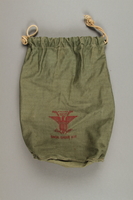
US Army pouch for a shoe shine kit issued to Milton Emont
Object
United States Army pouch for a shoe shine kit, issued to Milton Emont, a Jewish American World War II veteran. Milton was born to Polish parents in Paterson, New Jersey. He showed an aptitude for languages at a young age, and earned his Bachelor’s degree in French and Spanish. Milton registered for the draft in 1942, and entered active service on March 5, 1943. In the Army, Milton served 22 months in the 3189th Signal Service Battalion. As a translator and teletype operator, he was responsible for sending and receiving messages in Section Headquarters located in both France and Germany. In 1945, while in France, he was able to complete eight weeks of graduate coursework in French and French literature. After the war, he returned briefly to the United States and was discharged from the army on April 16, 1946. He then traveled back to France to spend a year as a teletype operator for Trans World Airline Company (TWA), returning to the United States on June 21, 1947. He obtained a Master’s degree from Middlebury College in 1948, and began his doctorate work at the University of Wisconsin in 1949. While there, Milton met Marietta Gruenbaum, a Jewish immigrant who had spent two and a half years in Theresienstadt ghetto-labor camp in German-occupied Czechoslovakia. Marietta completed her bachelor’s and master’s degrees on a Hillel scholarship. She met Milton during her final semester, and the two began seeing each other on group dates. After three months, when Marietta’s visa was due to expire, Milton proposed. The couple married in January 1950.
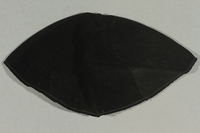
Black yarmulke owned by Milton Emont and likely used during World War II
Object
Cloth yarmulke, likely used during World War II, belonging to Milton Emont, a Jewish American World War II veteran. Milton was born to Polish parents in Paterson, New Jersey. He showed an aptitude for languages at a young age, and earned his Bachelor’s degree in French and Spanish. Milton registered for the draft in 1942, and entered active service on March 5, 1943. In the Army, Milton served 22 months in the 3189th Signal Service Battalion. As a translator and teletype operator, he was responsible for sending and receiving messages in Section Headquarters located in both France and Germany. In 1945, while in France, he was able to complete eight weeks of graduate coursework in French and French literature. After the war, he returned briefly to the United States and was discharged from the army on April 16, 1946. He then traveled back to France to spend a year as a teletype operator for Trans World Airline Company (TWA), returning to the United States on June 21, 1947. He obtained a Master’s degree from Middlebury College in 1948, and began his doctorate work at the University of Wisconsin in 1949. While there, Milton met Marietta Gruenbaum, a Jewish immigrant who had spent two and a half years in Theresienstadt ghetto-labor camp in German-occupied Czechoslovakia. Marietta completed her bachelor’s and master’s degrees on a Hillel scholarship. She met Milton during her final semester, and the two began seeing each other on group dates. After three months, when Marietta’s visa was due to expire, Milton proposed. The couple married in January 1950.
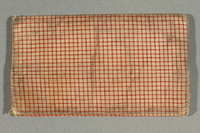
Multi-colored, cloth document cover used by Marietta Gruenbaum
Object
Cloth document cover, used by Marietta Gruenbaum, a Jewish-Czechoslovakian girl who was held in Theresienstadt ghetto-labor camp. Before Czechoslovakia was occupied by Germany in 1939, Marietta lived in Prague with her parents, Margarete and Karel, and her brother, Michael. In October 1941, Karel was arrested by the Gestapo and detained in Pankrác prison in Prague. On December 3, Karel was sent to Theresienstadt, where he was killed on the 18th in the Small Fortress. On November 20, 1942, Margarete, Michael, and Marietta were sent to the ghetto-labor camp aboard transport Cc. Marietta worked in the camp laundry. When the family received orders for deportation to Auschwitz killing center in German-occupied Poland in the fall of 1944, Margarete leveraged her job in the art studio to remove her family from the transport list. They were liberated from Theresienstadt on May 8, 1945, by the Soviet Army, and returned to Prague. In 1946, Marietta traveled to London for nine months before receiving a scholarship to attend the University of Wisconsin in the United States. During her final semester, she met Milton Emont, a Ph.D. student who had served in the U.S. Army. The couple began seeing each other on group dates. After three months, when Marietta’s visa was due to expire, Milton proposed. They married in January 1950.
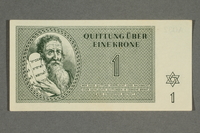
Theresienstadt ghetto-labor camp scrip, 1 krone note, acquired by Marietta Gruenbaum
Object
Scrip, valued at 1 krone, acquired by Marietta Gruenbaum, a Jewish-Czechoslovakian girl who was held in Theresienstadt ghetto-labor camp. Currency was confiscated from inmates and replaced with scrip, which could only be used in the camp. The scrip was part of an elaborate illusion to make the camp seem normal and appear as though workers were being paid for their labor, but the money had no real monetary value. Before Czechoslovakia was occupied by Germany in 1939, Marietta lived in Prague with her parents, Karel and Margarete, and her brother, Michael. In October 1941, Karel was arrested by the Gestapo and detained in Pankrác prison in Prague. On December 3, Karel was sent to Theresienstadt, where he was killed on the 18th in the Small Fortress. On November 20, 1942, Margarete, Michael, and Marietta were sent to the ghetto-labor camp aboard transport Cc. Marietta worked in the camp laundry. When the family received orders for deportation to Auschwitz killing center in German-occupied Poland in the fall of 1944, Margarete leveraged her job in the art studio to remove her family from the transport list. They were liberated from Theresienstadt on May 8, 1945, by the Soviet Army, and returned to Prague. In 1946, Marietta traveled to London for nine months before receiving a scholarship to attend the University of Wisconsin in the United States. During her final semester, she met Milton Emont, a Ph.D. student who had served in the U.S. Army. The couple began seeing each other on group dates. After three months, when Marietta’s visa was due to expire, Milton proposed. They married in January 1950.
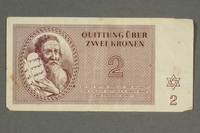
Theresienstadt ghetto-labor camp scrip, 2 kronen note, acquired by Marietta Gruenbaum
Object
Scrip, valued at 2 kronen, acquired by Marietta Gruenbaum, a Jewish-Czechoslovakian girl who was held in Theresienstadt ghetto-labor camp. Currency was confiscated from inmates and replaced with scrip, which could only be used in the camp. The scrip was part of an elaborate illusion to make the camp seem normal and appear as though workers were being paid for their labor, but the money had no real monetary value. Before Czechoslovakia was occupied by Germany in 1939, Marietta lived in Prague with her parents, Karel and Margarete, and her brother, Michael. In October 1941, Karel was arrested by the Gestapo and detained in Pankrác prison in Prague. On December 3, Karel was sent to Theresienstadt, where he was killed on the 18th in the Small Fortress. On November 20, 1942, Margarete, Michael, and Marietta were sent to the ghetto-labor camp aboard transport Cc. Marietta worked in the camp laundry. When the family received orders for deportation to Auschwitz killing center in German-occupied Poland in the fall of 1944, Margarete leveraged her job in the art studio to remove her family from the transport list. They were liberated from Theresienstadt on May 8, 1945, by the Soviet Army, and returned to Prague. In 1946, Marietta traveled to London for nine months before receiving a scholarship to attend the University of Wisconsin in the United States. During her final semester, she met Milton Emont, a Ph.D. student who had served in the U.S. Army. The couple began seeing each other on group dates. After three months, when Marietta’s visa was due to expire, Milton proposed. They married in January 1950.
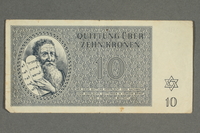
Theresienstadt ghetto-labor camp scrip, 10 kronen note, acquired by Marietta Gruenbaum
Object
Scrip, valued at 10 kronen, acquired by Marietta Gruenbaum, a Jewish-Czechoslovakian girl who was held in Theresienstadt ghetto-labor camp. Currency was confiscated from inmates and replaced with scrip, which could only be used in the camp. The scrip was part of an elaborate illusion to make the camp seem normal and appear as though workers were being paid for their labor, but the money had no real monetary value. Before Czechoslovakia was occupied by Germany in 1939, Marietta lived in Prague with her parents, Karel and Margarete, and her brother, Michael. In October 1941, Karel was arrested by the Gestapo and detained in Pankrác prison in Prague. On December 3, Karel was sent to Theresienstadt, where he was killed on the 18th in the Small Fortress. On November 20, 1942, Margarete, Michael, and Marietta were sent to the ghetto-labor camp aboard transport Cc. Marietta worked in the camp laundry. When the family received orders for deportation to Auschwitz killing center in German-occupied Poland in the fall of 1944, Margarete leveraged her job in the art studio to remove her family from the transport list. They were liberated from Theresienstadt on May 8, 1945, by the Soviet Army, and returned to Prague. In 1946, Marietta traveled to London for nine months before receiving a scholarship to attend the University of Wisconsin in the United States. During her final semester, she met Milton Emont, a Ph.D. student who had served in the U.S. Army. The couple began seeing each other on group dates. After three months, when Marietta’s visa was due to expire, Milton proposed. They married in January 1950.
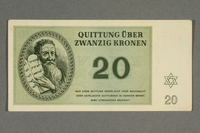
Theresienstadt ghetto-labor camp scrip, 20 kronen note, acquired by Marietta Gruenbaum
Object
Scrip, valued at 20 kronen, acquired by Marietta Gruenbaum, a Jewish-Czechoslovakian girl who was held in Theresienstadt ghetto-labor camp. Currency was confiscated from inmates and replaced with scrip, which could only be used in the camp. The scrip was part of an elaborate illusion to make the camp seem normal and appear as though workers were being paid for their labor, but the money had no real monetary value. Before Czechoslovakia was occupied by Germany in 1939, Marietta lived in Prague with her parents, Karel and Margarete, and her brother, Michael. In October 1941, Karel was arrested by the Gestapo and detained in Pankrác prison in Prague. On December 3, Karel was sent to Theresienstadt, where he was killed on the 18th in the Small Fortress. On November 20, 1942, Margarete, Michael, and Marietta were sent to the ghetto-labor camp aboard transport Cc. Marietta worked in the camp laundry. When the family received orders for deportation to Auschwitz killing center in German-occupied Poland in the fall of 1944, Margarete leveraged her job in the art studio to remove her family from the transport list. They were liberated from Theresienstadt on May 8, 1945, by the Soviet Army, and returned to Prague. In 1946, Marietta traveled to London for nine months before receiving a scholarship to attend the University of Wisconsin in the United States. During her final semester, she met Milton Emont, a Ph.D. student who had served in the U.S. Army. The couple began seeing each other on group dates. After three months, when Marietta’s visa was due to expire, Milton proposed. They married in January 1950.
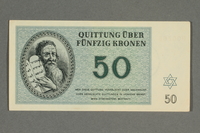
Theresienstadt ghetto-labor camp scrip, 50 kronen note, acquired by Marietta Gruenbaum
Object
Scrip, valued at 50 kronen, acquired by Marietta Gruenbaum, a Jewish-Czechoslovakian girl who was held in Theresienstadt ghetto-labor camp. Currency was confiscated from inmates and replaced with scrip, which could only be used in the camp. The scrip was part of an elaborate illusion to make the camp seem normal and appear as though workers were being paid for their labor, but the money had no real monetary value. Before Czechoslovakia was occupied by Germany in 1939, Marietta lived in Prague with her parents, Karel and Margarete, and her brother, Michael. In October 1941, Karel was arrested by the Gestapo and detained in Pankrác prison in Prague. On December 3, Karel was sent to Theresienstadt, where he was killed on the 18th in the Small Fortress. On November 20, 1942, Margarete, Michael, and Marietta were sent to the ghetto-labor camp aboard transport Cc. Marietta worked in the camp laundry. When the family received orders for deportation to Auschwitz killing center in German-occupied Poland in the fall of 1944, Margarete leveraged her job in the art studio to remove her family from the transport list. They were liberated from Theresienstadt on May 8, 1945, by the Soviet Army, and returned to Prague. In 1946, Marietta traveled to London for nine months before receiving a scholarship to attend the University of Wisconsin in the United States. During her final semester, she met Milton Emont, a Ph.D. student who had served in the U.S. Army. The couple began seeing each other on group dates. After three months, when Marietta’s visa was due to expire, Milton proposed. They married in January 1950.
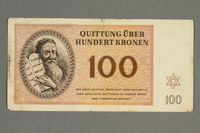
Theresienstadt ghetto-labor camp scrip, 100 kronen note, acquired by Marietta Gruenbaum
Object
Scrip, valued at 100 kronen, acquired by Marietta Gruenbaum, a Jewish-Czechoslovakian girl who was held in Theresienstadt ghetto-labor camp. Currency was confiscated from inmates and replaced with scrip, which could only be used in the camp. The scrip was part of an elaborate illusion to make the camp seem normal and appear as though workers were being paid for their labor, but the money had no real monetary value. Before Czechoslovakia was occupied by Germany in 1939, Marietta lived in Prague with her parents, Karel and Margarete, and her brother, Michael. In October 1941, Karel was arrested by the Gestapo and detained in Pankrác prison in Prague. On December 3, Karel was sent to Theresienstadt, where he was killed on the 18th in the Small Fortress. On November 20, 1942, Margarete, Michael, and Marietta were sent to the ghetto-labor camp aboard transport Cc. Marietta worked in the camp laundry. When the family received orders for deportation to Auschwitz killing center in German-occupied Poland in the fall of 1944, Margarete leveraged her job in the art studio to remove her family from the transport list. They were liberated from Theresienstadt on May 8, 1945, by the Soviet Army, and returned to Prague. In 1946, Marietta traveled to London for nine months before receiving a scholarship to attend the University of Wisconsin in the United States. During her final semester, she met Milton Emont, a Ph.D. student who had served in the U.S. Army. The couple began seeing each other on group dates. After three months, when Marietta’s visa was due to expire, Milton proposed. They married in January 1950.
Marietta Gruenbaum papers
Document
Contains documents, correspondence, ephemera (including ration cards, menus, pamphlets, clippings, magazines), photos (both personal and commercial photo packages), and US government-issued Jewish religious items documenting the experiences of Mariette Gruenbaum, a survivor of Theresienstadt. Documents her life in Czechoslovakia, England, immigration to the United States, and travels to France.
Booklet, Elite Information
Object
Guide to Switzerland intended for American G.I.s, presented by Swiss tradesmen as a souvenir of the leave spent in Switzerland.
Booklet, 90 Versions Britanniques et Americaines pour les candidats au baccalaureat
Object
Textbook published by the Librairie Hachette. 1951 edition.





